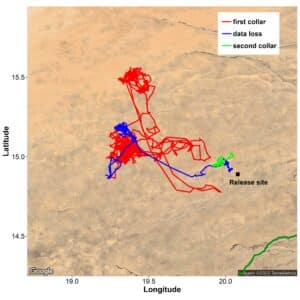The lost and found oryx
Observing where scimitar-horned oryx move and how they behave after release helps us understand and protect them.

We use field work and GPS collars programmed to drop off after 2-3 years to collect this important information.
In 2021, we captured a female oryx who was born in the pre-release pens in April 2018. We fitted her with a GPS collar, collected samples, and released her back into the wild.
After she was collared, she traveled almost 100km from the release site – a real explorer!
Unfortunately, her collar stopped transmitting five months ago, so we did not know where she was, or if she was ok.
Luckily, our ecological monitoring team observed her during routine monitoring in early November.
Later that month, we were able to capture her again and remove her first collar. We also collected more samples and fit her with a second collar.
We recovered several months of “missing” data from her first collar. Though she has traveled far and returned in recent months, she has spent most of her time within 40km of the release site.
On the photo you can see where she wandered about!

Using these field and movement data, our partners at the Smithsonian’s National Zoo and Conservation Biology Institute and the Zoological Society of London study where reintroduced oryx might disperse across the reserve, and what vegetation types and habitats they prefer.
How do reintroduced oryx navigate unfamiliar landscapes? Is it instinct? Do newly released oryx learn from more experienced animals? Exciting topics we plan to investigate in 2024!

